Business Law and Globalisation
VerifiedAdded on 2020/06/04
|12
|3946
|151
AI Summary
This assignment examines the complex relationship between business law and globalization. It delves into topics such as the influence of international trade agreements, ethical dilemmas faced by businesses operating across borders, and the role of anti-bribery laws in promoting transparency. Students will analyze various perspectives on how globalization shapes legal frameworks and business practices, considering both opportunities and challenges.
Contribute Materials
Your contribution can guide someone’s learning journey. Share your
documents today.
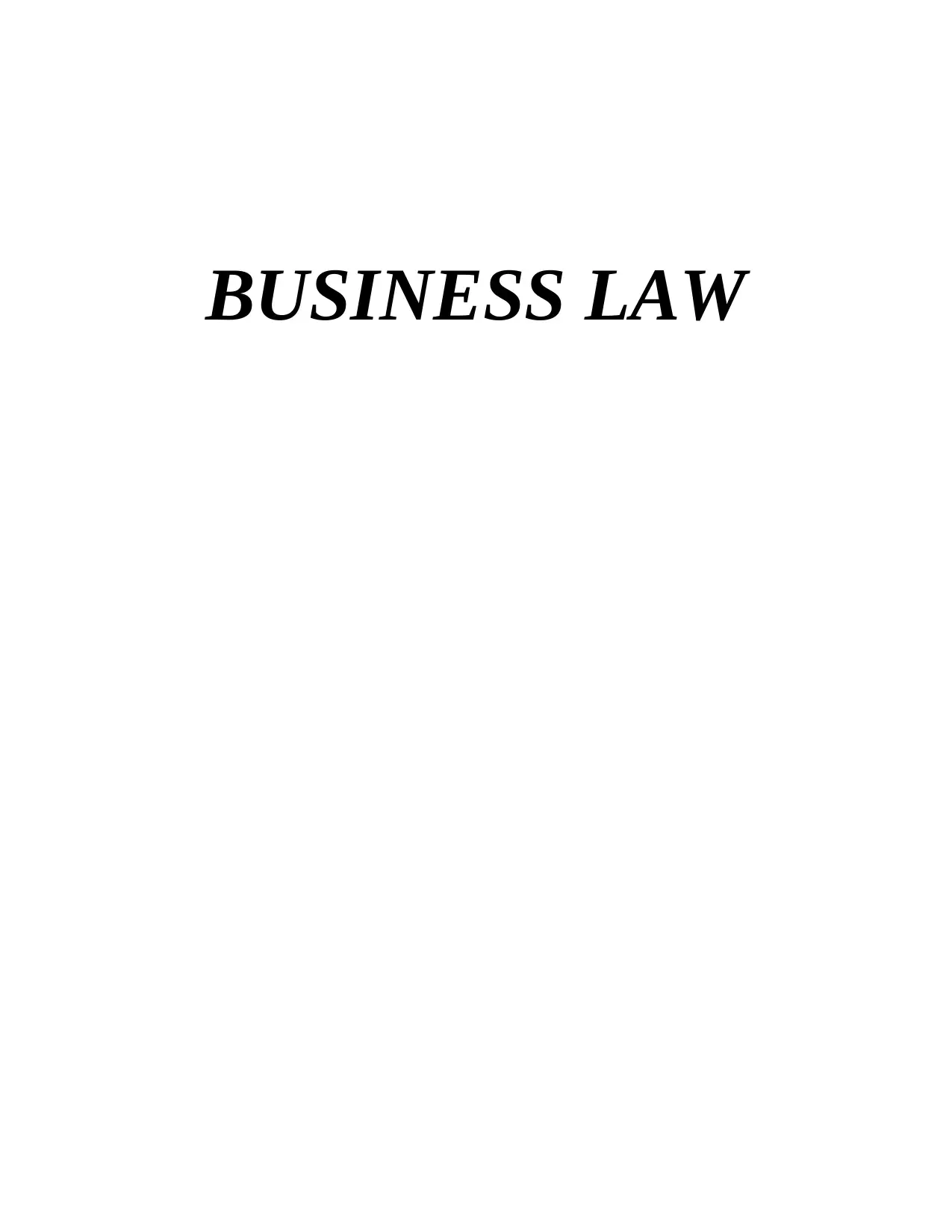
BUSINESS LAW
Secure Best Marks with AI Grader
Need help grading? Try our AI Grader for instant feedback on your assignments.
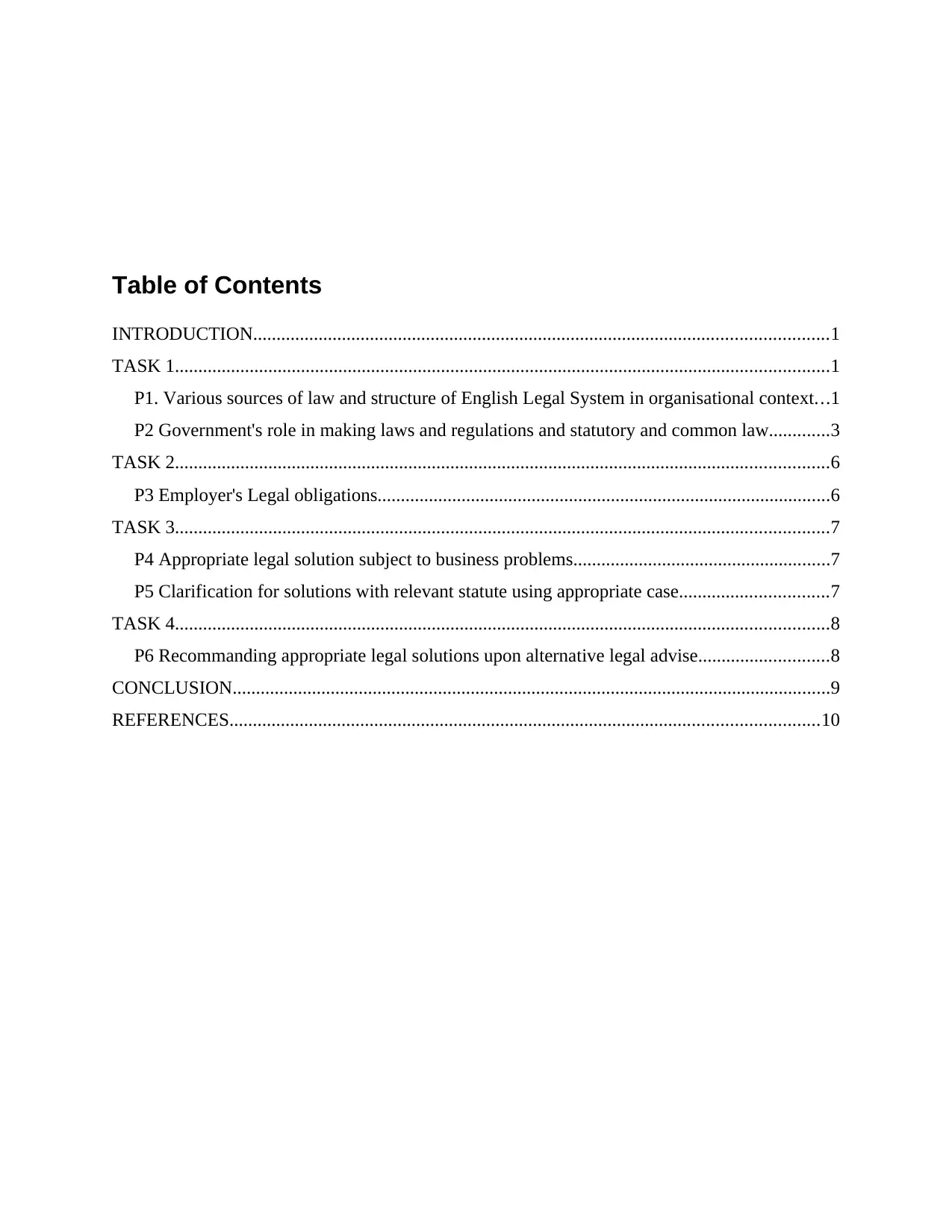
Table of Contents
INTRODUCTION...........................................................................................................................1
TASK 1............................................................................................................................................1
P1. Various sources of law and structure of English Legal System in organisational context...1
P2 Government's role in making laws and regulations and statutory and common law.............3
TASK 2............................................................................................................................................6
P3 Employer's Legal obligations.................................................................................................6
TASK 3............................................................................................................................................7
P4 Appropriate legal solution subject to business problems.......................................................7
P5 Clarification for solutions with relevant statute using appropriate case................................7
TASK 4............................................................................................................................................8
P6 Recommanding appropriate legal solutions upon alternative legal advise............................8
CONCLUSION................................................................................................................................9
REFERENCES..............................................................................................................................10
INTRODUCTION...........................................................................................................................1
TASK 1............................................................................................................................................1
P1. Various sources of law and structure of English Legal System in organisational context...1
P2 Government's role in making laws and regulations and statutory and common law.............3
TASK 2............................................................................................................................................6
P3 Employer's Legal obligations.................................................................................................6
TASK 3............................................................................................................................................7
P4 Appropriate legal solution subject to business problems.......................................................7
P5 Clarification for solutions with relevant statute using appropriate case................................7
TASK 4............................................................................................................................................8
P6 Recommanding appropriate legal solutions upon alternative legal advise............................8
CONCLUSION................................................................................................................................9
REFERENCES..............................................................................................................................10
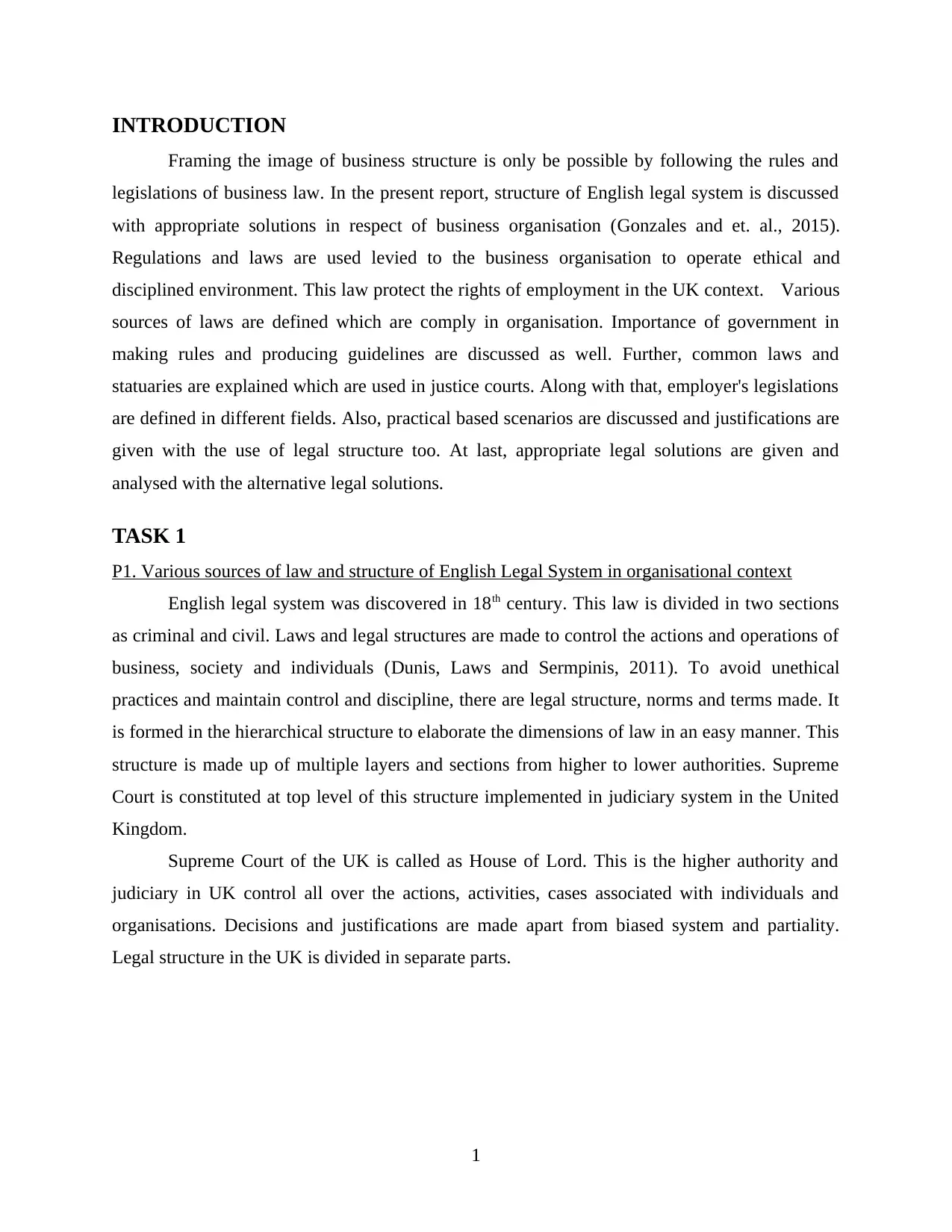
INTRODUCTION
Framing the image of business structure is only be possible by following the rules and
legislations of business law. In the present report, structure of English legal system is discussed
with appropriate solutions in respect of business organisation (Gonzales and et. al., 2015).
Regulations and laws are used levied to the business organisation to operate ethical and
disciplined environment. This law protect the rights of employment in the UK context. Various
sources of laws are defined which are comply in organisation. Importance of government in
making rules and producing guidelines are discussed as well. Further, common laws and
statuaries are explained which are used in justice courts. Along with that, employer's legislations
are defined in different fields. Also, practical based scenarios are discussed and justifications are
given with the use of legal structure too. At last, appropriate legal solutions are given and
analysed with the alternative legal solutions.
TASK 1
P1. Various sources of law and structure of English Legal System in organisational context
English legal system was discovered in 18th century. This law is divided in two sections
as criminal and civil. Laws and legal structures are made to control the actions and operations of
business, society and individuals (Dunis, Laws and Sermpinis, 2011). To avoid unethical
practices and maintain control and discipline, there are legal structure, norms and terms made. It
is formed in the hierarchical structure to elaborate the dimensions of law in an easy manner. This
structure is made up of multiple layers and sections from higher to lower authorities. Supreme
Court is constituted at top level of this structure implemented in judiciary system in the United
Kingdom.
Supreme Court of the UK is called as House of Lord. This is the higher authority and
judiciary in UK control all over the actions, activities, cases associated with individuals and
organisations. Decisions and justifications are made apart from biased system and partiality.
Legal structure in the UK is divided in separate parts.
1
Framing the image of business structure is only be possible by following the rules and
legislations of business law. In the present report, structure of English legal system is discussed
with appropriate solutions in respect of business organisation (Gonzales and et. al., 2015).
Regulations and laws are used levied to the business organisation to operate ethical and
disciplined environment. This law protect the rights of employment in the UK context. Various
sources of laws are defined which are comply in organisation. Importance of government in
making rules and producing guidelines are discussed as well. Further, common laws and
statuaries are explained which are used in justice courts. Along with that, employer's legislations
are defined in different fields. Also, practical based scenarios are discussed and justifications are
given with the use of legal structure too. At last, appropriate legal solutions are given and
analysed with the alternative legal solutions.
TASK 1
P1. Various sources of law and structure of English Legal System in organisational context
English legal system was discovered in 18th century. This law is divided in two sections
as criminal and civil. Laws and legal structures are made to control the actions and operations of
business, society and individuals (Dunis, Laws and Sermpinis, 2011). To avoid unethical
practices and maintain control and discipline, there are legal structure, norms and terms made. It
is formed in the hierarchical structure to elaborate the dimensions of law in an easy manner. This
structure is made up of multiple layers and sections from higher to lower authorities. Supreme
Court is constituted at top level of this structure implemented in judiciary system in the United
Kingdom.
Supreme Court of the UK is called as House of Lord. This is the higher authority and
judiciary in UK control all over the actions, activities, cases associated with individuals and
organisations. Decisions and justifications are made apart from biased system and partiality.
Legal structure in the UK is divided in separate parts.
1
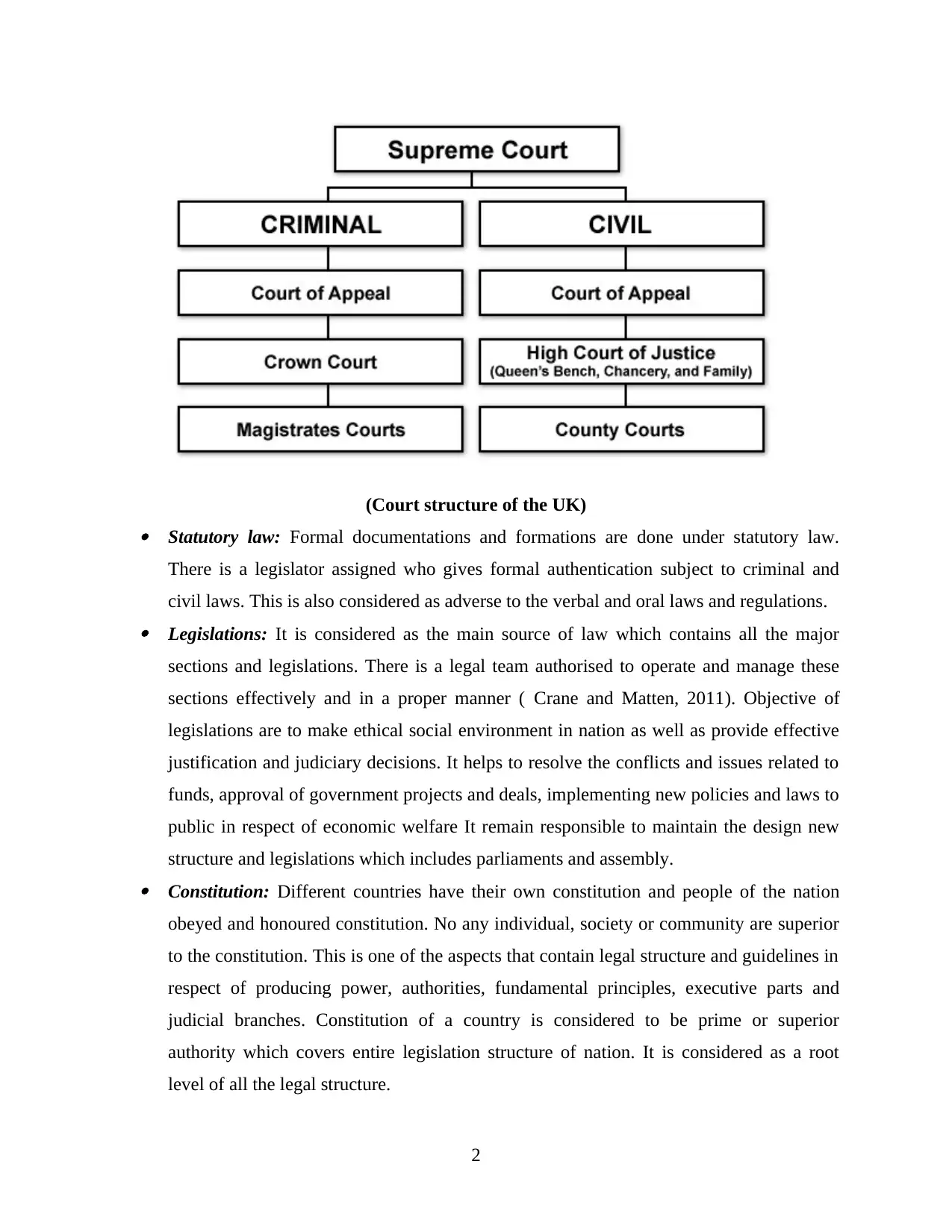
(Court structure of the UK) Statutory law: Formal documentations and formations are done under statutory law.
There is a legislator assigned who gives formal authentication subject to criminal and
civil laws. This is also considered as adverse to the verbal and oral laws and regulations. Legislations: It is considered as the main source of law which contains all the major
sections and legislations. There is a legal team authorised to operate and manage these
sections effectively and in a proper manner ( Crane and Matten, 2011). Objective of
legislations are to make ethical social environment in nation as well as provide effective
justification and judiciary decisions. It helps to resolve the conflicts and issues related to
funds, approval of government projects and deals, implementing new policies and laws to
public in respect of economic welfare It remain responsible to maintain the design new
structure and legislations which includes parliaments and assembly. Constitution: Different countries have their own constitution and people of the nation
obeyed and honoured constitution. No any individual, society or community are superior
to the constitution. This is one of the aspects that contain legal structure and guidelines in
respect of producing power, authorities, fundamental principles, executive parts and
judicial branches. Constitution of a country is considered to be prime or superior
authority which covers entire legislation structure of nation. It is considered as a root
level of all the legal structure.
2
There is a legislator assigned who gives formal authentication subject to criminal and
civil laws. This is also considered as adverse to the verbal and oral laws and regulations. Legislations: It is considered as the main source of law which contains all the major
sections and legislations. There is a legal team authorised to operate and manage these
sections effectively and in a proper manner ( Crane and Matten, 2011). Objective of
legislations are to make ethical social environment in nation as well as provide effective
justification and judiciary decisions. It helps to resolve the conflicts and issues related to
funds, approval of government projects and deals, implementing new policies and laws to
public in respect of economic welfare It remain responsible to maintain the design new
structure and legislations which includes parliaments and assembly. Constitution: Different countries have their own constitution and people of the nation
obeyed and honoured constitution. No any individual, society or community are superior
to the constitution. This is one of the aspects that contain legal structure and guidelines in
respect of producing power, authorities, fundamental principles, executive parts and
judicial branches. Constitution of a country is considered to be prime or superior
authority which covers entire legislation structure of nation. It is considered as a root
level of all the legal structure.
2
Secure Best Marks with AI Grader
Need help grading? Try our AI Grader for instant feedback on your assignments.
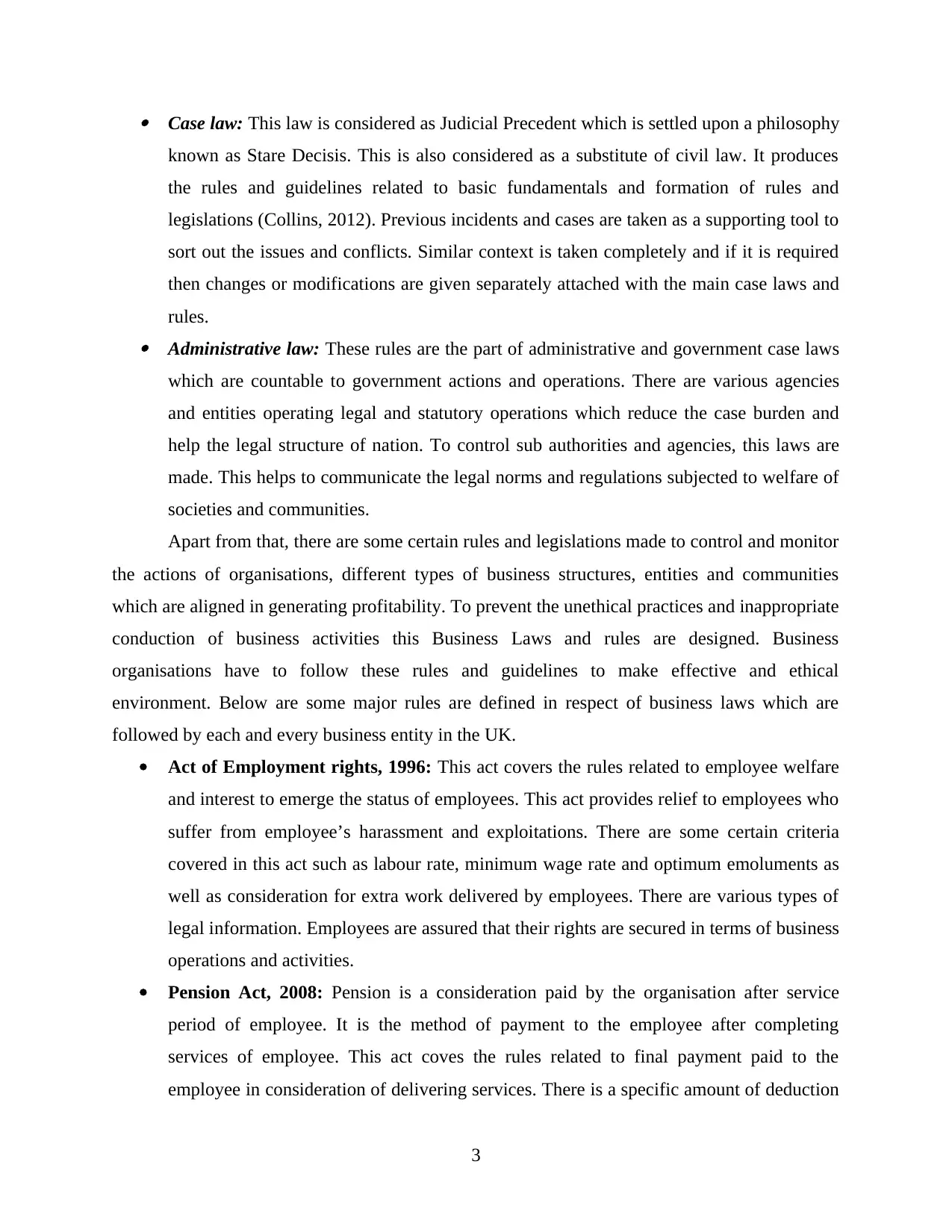
Case law: This law is considered as Judicial Precedent which is settled upon a philosophy
known as Stare Decisis. This is also considered as a substitute of civil law. It produces
the rules and guidelines related to basic fundamentals and formation of rules and
legislations (Collins, 2012). Previous incidents and cases are taken as a supporting tool to
sort out the issues and conflicts. Similar context is taken completely and if it is required
then changes or modifications are given separately attached with the main case laws and
rules. Administrative law: These rules are the part of administrative and government case laws
which are countable to government actions and operations. There are various agencies
and entities operating legal and statutory operations which reduce the case burden and
help the legal structure of nation. To control sub authorities and agencies, this laws are
made. This helps to communicate the legal norms and regulations subjected to welfare of
societies and communities.
Apart from that, there are some certain rules and legislations made to control and monitor
the actions of organisations, different types of business structures, entities and communities
which are aligned in generating profitability. To prevent the unethical practices and inappropriate
conduction of business activities this Business Laws and rules are designed. Business
organisations have to follow these rules and guidelines to make effective and ethical
environment. Below are some major rules are defined in respect of business laws which are
followed by each and every business entity in the UK.
Act of Employment rights, 1996: This act covers the rules related to employee welfare
and interest to emerge the status of employees. This act provides relief to employees who
suffer from employee’s harassment and exploitations. There are some certain criteria
covered in this act such as labour rate, minimum wage rate and optimum emoluments as
well as consideration for extra work delivered by employees. There are various types of
legal information. Employees are assured that their rights are secured in terms of business
operations and activities.
Pension Act, 2008: Pension is a consideration paid by the organisation after service
period of employee. It is the method of payment to the employee after completing
services of employee. This act coves the rules related to final payment paid to the
employee in consideration of delivering services. There is a specific amount of deduction
3
known as Stare Decisis. This is also considered as a substitute of civil law. It produces
the rules and guidelines related to basic fundamentals and formation of rules and
legislations (Collins, 2012). Previous incidents and cases are taken as a supporting tool to
sort out the issues and conflicts. Similar context is taken completely and if it is required
then changes or modifications are given separately attached with the main case laws and
rules. Administrative law: These rules are the part of administrative and government case laws
which are countable to government actions and operations. There are various agencies
and entities operating legal and statutory operations which reduce the case burden and
help the legal structure of nation. To control sub authorities and agencies, this laws are
made. This helps to communicate the legal norms and regulations subjected to welfare of
societies and communities.
Apart from that, there are some certain rules and legislations made to control and monitor
the actions of organisations, different types of business structures, entities and communities
which are aligned in generating profitability. To prevent the unethical practices and inappropriate
conduction of business activities this Business Laws and rules are designed. Business
organisations have to follow these rules and guidelines to make effective and ethical
environment. Below are some major rules are defined in respect of business laws which are
followed by each and every business entity in the UK.
Act of Employment rights, 1996: This act covers the rules related to employee welfare
and interest to emerge the status of employees. This act provides relief to employees who
suffer from employee’s harassment and exploitations. There are some certain criteria
covered in this act such as labour rate, minimum wage rate and optimum emoluments as
well as consideration for extra work delivered by employees. There are various types of
legal information. Employees are assured that their rights are secured in terms of business
operations and activities.
Pension Act, 2008: Pension is a consideration paid by the organisation after service
period of employee. It is the method of payment to the employee after completing
services of employee. This act coves the rules related to final payment paid to the
employee in consideration of delivering services. There is a specific amount of deduction
3
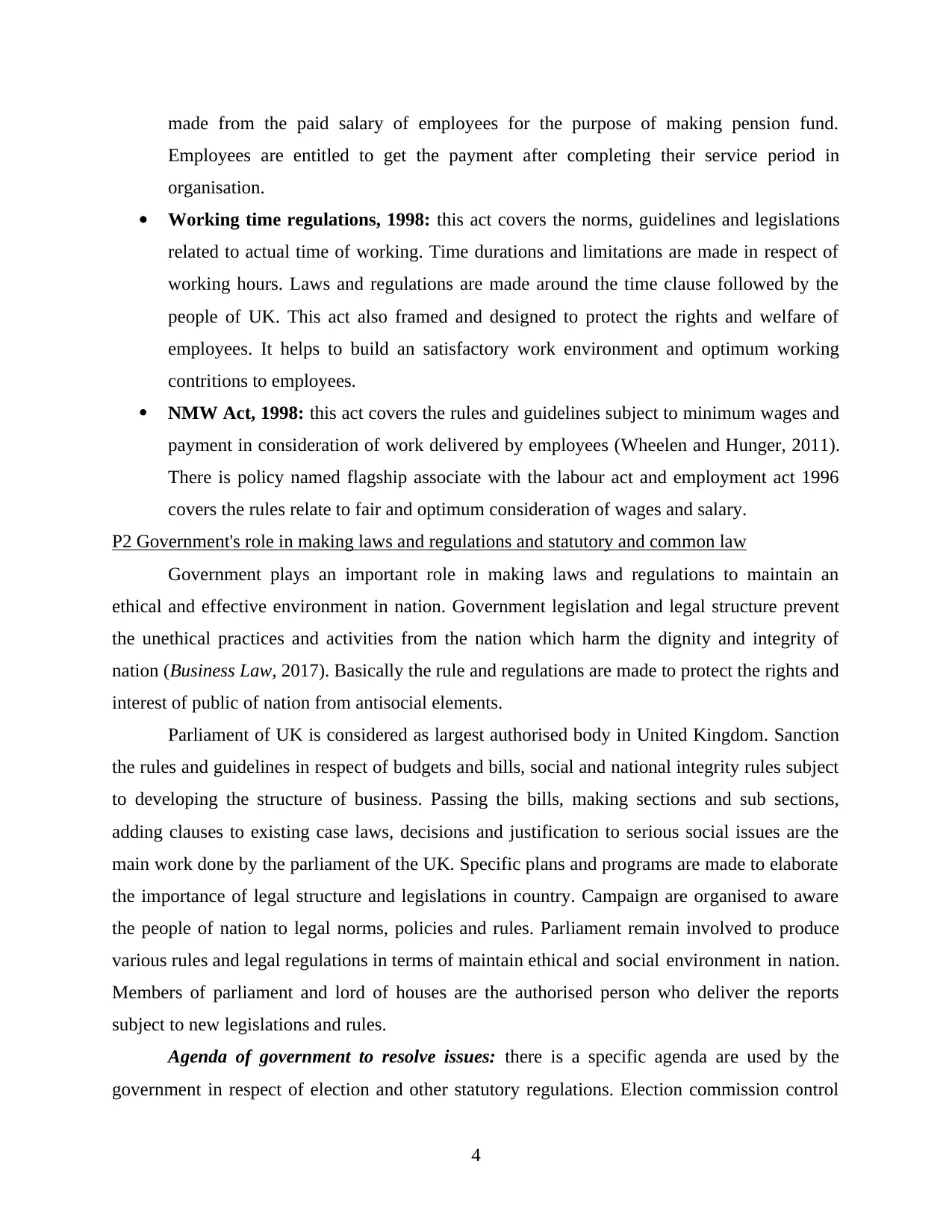
made from the paid salary of employees for the purpose of making pension fund.
Employees are entitled to get the payment after completing their service period in
organisation.
Working time regulations, 1998: this act covers the norms, guidelines and legislations
related to actual time of working. Time durations and limitations are made in respect of
working hours. Laws and regulations are made around the time clause followed by the
people of UK. This act also framed and designed to protect the rights and welfare of
employees. It helps to build an satisfactory work environment and optimum working
contritions to employees.
NMW Act, 1998: this act covers the rules and guidelines subject to minimum wages and
payment in consideration of work delivered by employees (Wheelen and Hunger, 2011).
There is policy named flagship associate with the labour act and employment act 1996
covers the rules relate to fair and optimum consideration of wages and salary.
P2 Government's role in making laws and regulations and statutory and common law
Government plays an important role in making laws and regulations to maintain an
ethical and effective environment in nation. Government legislation and legal structure prevent
the unethical practices and activities from the nation which harm the dignity and integrity of
nation (Business Law, 2017). Basically the rule and regulations are made to protect the rights and
interest of public of nation from antisocial elements.
Parliament of UK is considered as largest authorised body in United Kingdom. Sanction
the rules and guidelines in respect of budgets and bills, social and national integrity rules subject
to developing the structure of business. Passing the bills, making sections and sub sections,
adding clauses to existing case laws, decisions and justification to serious social issues are the
main work done by the parliament of the UK. Specific plans and programs are made to elaborate
the importance of legal structure and legislations in country. Campaign are organised to aware
the people of nation to legal norms, policies and rules. Parliament remain involved to produce
various rules and legal regulations in terms of maintain ethical and social environment in nation.
Members of parliament and lord of houses are the authorised person who deliver the reports
subject to new legislations and rules.
Agenda of government to resolve issues: there is a specific agenda are used by the
government in respect of election and other statutory regulations. Election commission control
4
Employees are entitled to get the payment after completing their service period in
organisation.
Working time regulations, 1998: this act covers the norms, guidelines and legislations
related to actual time of working. Time durations and limitations are made in respect of
working hours. Laws and regulations are made around the time clause followed by the
people of UK. This act also framed and designed to protect the rights and welfare of
employees. It helps to build an satisfactory work environment and optimum working
contritions to employees.
NMW Act, 1998: this act covers the rules and guidelines subject to minimum wages and
payment in consideration of work delivered by employees (Wheelen and Hunger, 2011).
There is policy named flagship associate with the labour act and employment act 1996
covers the rules relate to fair and optimum consideration of wages and salary.
P2 Government's role in making laws and regulations and statutory and common law
Government plays an important role in making laws and regulations to maintain an
ethical and effective environment in nation. Government legislation and legal structure prevent
the unethical practices and activities from the nation which harm the dignity and integrity of
nation (Business Law, 2017). Basically the rule and regulations are made to protect the rights and
interest of public of nation from antisocial elements.
Parliament of UK is considered as largest authorised body in United Kingdom. Sanction
the rules and guidelines in respect of budgets and bills, social and national integrity rules subject
to developing the structure of business. Passing the bills, making sections and sub sections,
adding clauses to existing case laws, decisions and justification to serious social issues are the
main work done by the parliament of the UK. Specific plans and programs are made to elaborate
the importance of legal structure and legislations in country. Campaign are organised to aware
the people of nation to legal norms, policies and rules. Parliament remain involved to produce
various rules and legal regulations in terms of maintain ethical and social environment in nation.
Members of parliament and lord of houses are the authorised person who deliver the reports
subject to new legislations and rules.
Agenda of government to resolve issues: there is a specific agenda are used by the
government in respect of election and other statutory regulations. Election commission control
4
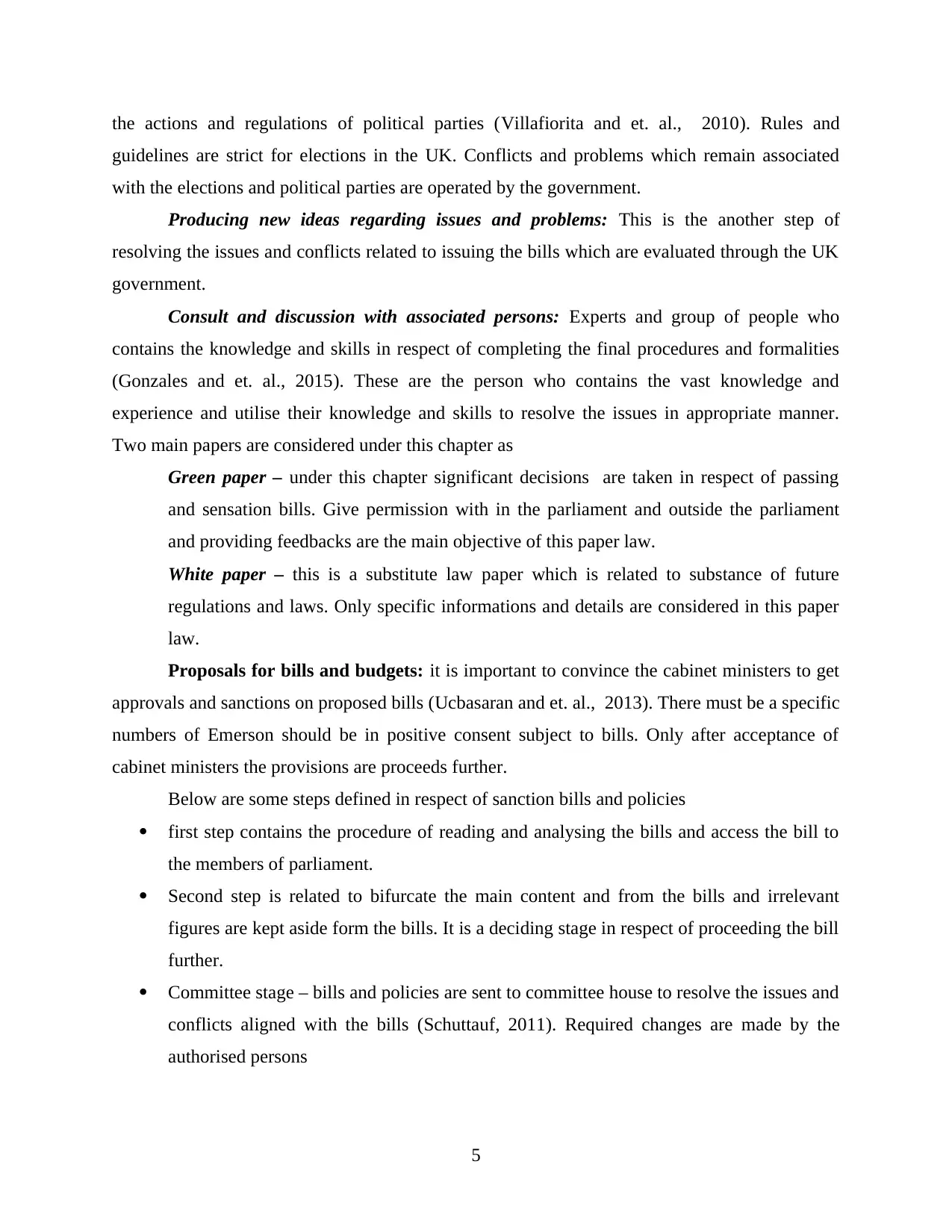
the actions and regulations of political parties (Villafiorita and et. al., 2010). Rules and
guidelines are strict for elections in the UK. Conflicts and problems which remain associated
with the elections and political parties are operated by the government.
Producing new ideas regarding issues and problems: This is the another step of
resolving the issues and conflicts related to issuing the bills which are evaluated through the UK
government.
Consult and discussion with associated persons: Experts and group of people who
contains the knowledge and skills in respect of completing the final procedures and formalities
(Gonzales and et. al., 2015). These are the person who contains the vast knowledge and
experience and utilise their knowledge and skills to resolve the issues in appropriate manner.
Two main papers are considered under this chapter as
Green paper – under this chapter significant decisions are taken in respect of passing
and sensation bills. Give permission with in the parliament and outside the parliament
and providing feedbacks are the main objective of this paper law.
White paper – this is a substitute law paper which is related to substance of future
regulations and laws. Only specific informations and details are considered in this paper
law.
Proposals for bills and budgets: it is important to convince the cabinet ministers to get
approvals and sanctions on proposed bills (Ucbasaran and et. al., 2013). There must be a specific
numbers of Emerson should be in positive consent subject to bills. Only after acceptance of
cabinet ministers the provisions are proceeds further.
Below are some steps defined in respect of sanction bills and policies
first step contains the procedure of reading and analysing the bills and access the bill to
the members of parliament.
Second step is related to bifurcate the main content and from the bills and irrelevant
figures are kept aside form the bills. It is a deciding stage in respect of proceeding the bill
further.
Committee stage – bills and policies are sent to committee house to resolve the issues and
conflicts aligned with the bills (Schuttauf, 2011). Required changes are made by the
authorised persons
5
guidelines are strict for elections in the UK. Conflicts and problems which remain associated
with the elections and political parties are operated by the government.
Producing new ideas regarding issues and problems: This is the another step of
resolving the issues and conflicts related to issuing the bills which are evaluated through the UK
government.
Consult and discussion with associated persons: Experts and group of people who
contains the knowledge and skills in respect of completing the final procedures and formalities
(Gonzales and et. al., 2015). These are the person who contains the vast knowledge and
experience and utilise their knowledge and skills to resolve the issues in appropriate manner.
Two main papers are considered under this chapter as
Green paper – under this chapter significant decisions are taken in respect of passing
and sensation bills. Give permission with in the parliament and outside the parliament
and providing feedbacks are the main objective of this paper law.
White paper – this is a substitute law paper which is related to substance of future
regulations and laws. Only specific informations and details are considered in this paper
law.
Proposals for bills and budgets: it is important to convince the cabinet ministers to get
approvals and sanctions on proposed bills (Ucbasaran and et. al., 2013). There must be a specific
numbers of Emerson should be in positive consent subject to bills. Only after acceptance of
cabinet ministers the provisions are proceeds further.
Below are some steps defined in respect of sanction bills and policies
first step contains the procedure of reading and analysing the bills and access the bill to
the members of parliament.
Second step is related to bifurcate the main content and from the bills and irrelevant
figures are kept aside form the bills. It is a deciding stage in respect of proceeding the bill
further.
Committee stage – bills and policies are sent to committee house to resolve the issues and
conflicts aligned with the bills (Schuttauf, 2011). Required changes are made by the
authorised persons
5
Paraphrase This Document
Need a fresh take? Get an instant paraphrase of this document with our AI Paraphraser
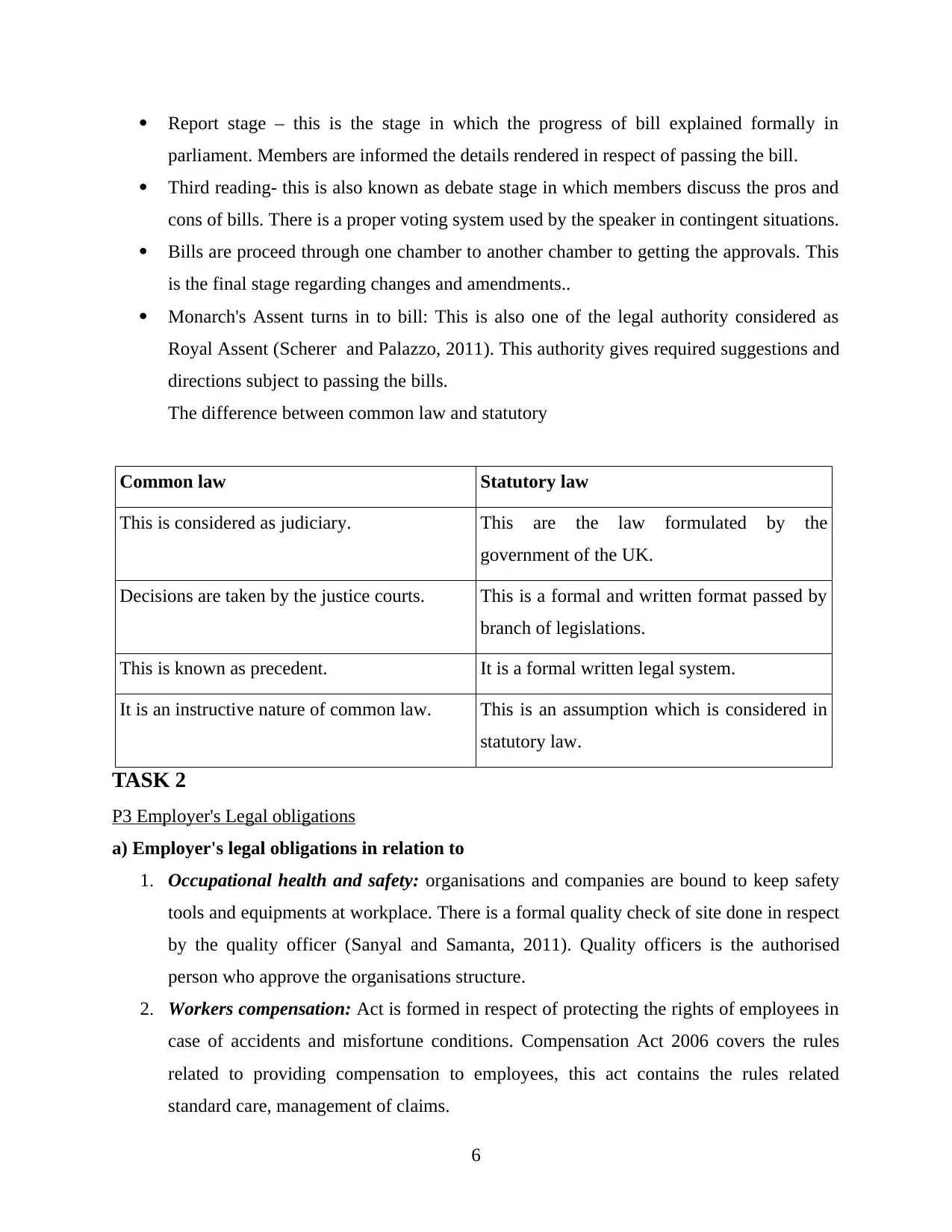
Report stage – this is the stage in which the progress of bill explained formally in
parliament. Members are informed the details rendered in respect of passing the bill.
Third reading- this is also known as debate stage in which members discuss the pros and
cons of bills. There is a proper voting system used by the speaker in contingent situations.
Bills are proceed through one chamber to another chamber to getting the approvals. This
is the final stage regarding changes and amendments..
Monarch's Assent turns in to bill: This is also one of the legal authority considered as
Royal Assent (Scherer and Palazzo, 2011). This authority gives required suggestions and
directions subject to passing the bills.
The difference between common law and statutory
Common law Statutory law
This is considered as judiciary. This are the law formulated by the
government of the UK.
Decisions are taken by the justice courts. This is a formal and written format passed by
branch of legislations.
This is known as precedent. It is a formal written legal system.
It is an instructive nature of common law. This is an assumption which is considered in
statutory law.
TASK 2
P3 Employer's Legal obligations
a) Employer's legal obligations in relation to
1. Occupational health and safety: organisations and companies are bound to keep safety
tools and equipments at workplace. There is a formal quality check of site done in respect
by the quality officer (Sanyal and Samanta, 2011). Quality officers is the authorised
person who approve the organisations structure.
2. Workers compensation: Act is formed in respect of protecting the rights of employees in
case of accidents and misfortune conditions. Compensation Act 2006 covers the rules
related to providing compensation to employees, this act contains the rules related
standard care, management of claims.
6
parliament. Members are informed the details rendered in respect of passing the bill.
Third reading- this is also known as debate stage in which members discuss the pros and
cons of bills. There is a proper voting system used by the speaker in contingent situations.
Bills are proceed through one chamber to another chamber to getting the approvals. This
is the final stage regarding changes and amendments..
Monarch's Assent turns in to bill: This is also one of the legal authority considered as
Royal Assent (Scherer and Palazzo, 2011). This authority gives required suggestions and
directions subject to passing the bills.
The difference between common law and statutory
Common law Statutory law
This is considered as judiciary. This are the law formulated by the
government of the UK.
Decisions are taken by the justice courts. This is a formal and written format passed by
branch of legislations.
This is known as precedent. It is a formal written legal system.
It is an instructive nature of common law. This is an assumption which is considered in
statutory law.
TASK 2
P3 Employer's Legal obligations
a) Employer's legal obligations in relation to
1. Occupational health and safety: organisations and companies are bound to keep safety
tools and equipments at workplace. There is a formal quality check of site done in respect
by the quality officer (Sanyal and Samanta, 2011). Quality officers is the authorised
person who approve the organisations structure.
2. Workers compensation: Act is formed in respect of protecting the rights of employees in
case of accidents and misfortune conditions. Compensation Act 2006 covers the rules
related to providing compensation to employees, this act contains the rules related
standard care, management of claims.
6
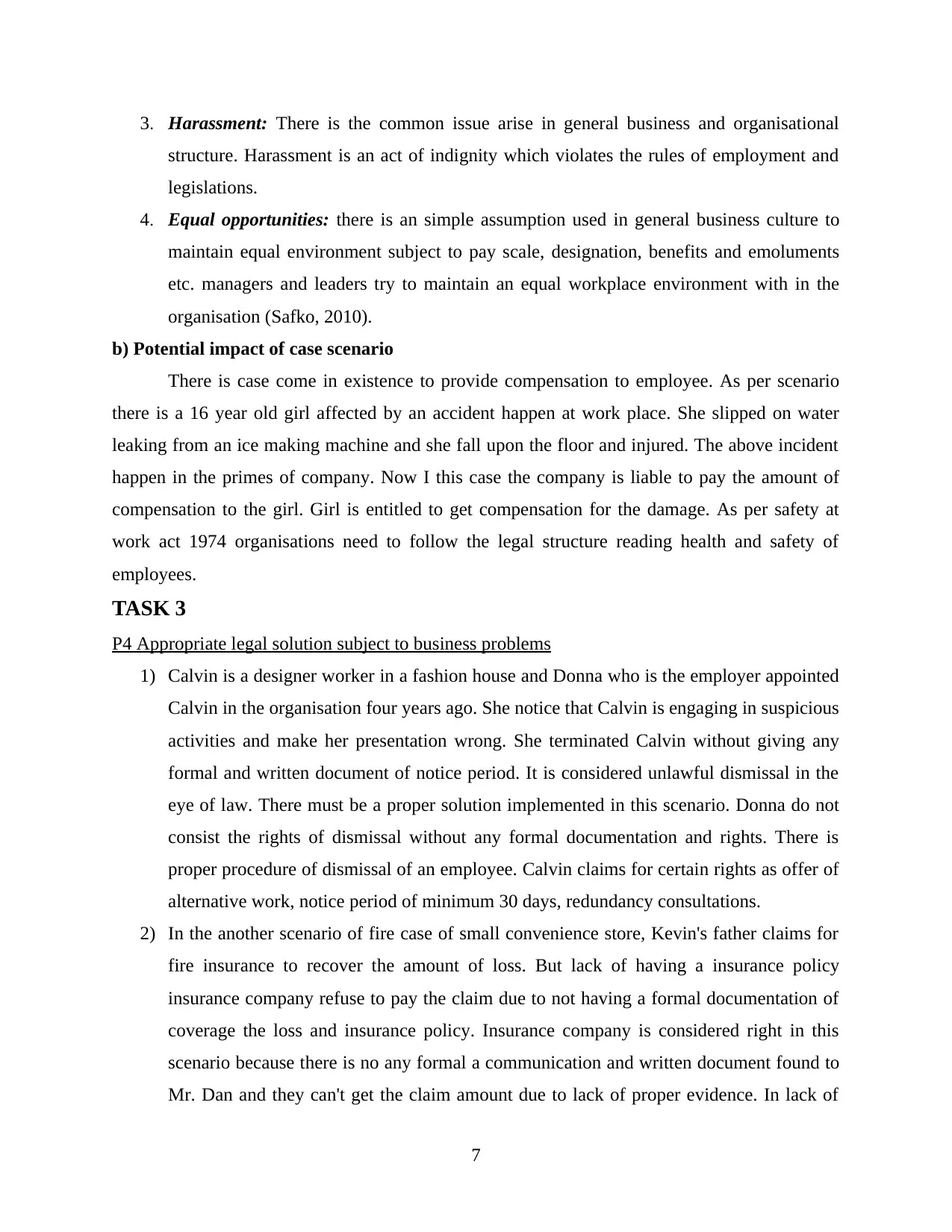
3. Harassment: There is the common issue arise in general business and organisational
structure. Harassment is an act of indignity which violates the rules of employment and
legislations.
4. Equal opportunities: there is an simple assumption used in general business culture to
maintain equal environment subject to pay scale, designation, benefits and emoluments
etc. managers and leaders try to maintain an equal workplace environment with in the
organisation (Safko, 2010).
b) Potential impact of case scenario
There is case come in existence to provide compensation to employee. As per scenario
there is a 16 year old girl affected by an accident happen at work place. She slipped on water
leaking from an ice making machine and she fall upon the floor and injured. The above incident
happen in the primes of company. Now I this case the company is liable to pay the amount of
compensation to the girl. Girl is entitled to get compensation for the damage. As per safety at
work act 1974 organisations need to follow the legal structure reading health and safety of
employees.
TASK 3
P4 Appropriate legal solution subject to business problems
1) Calvin is a designer worker in a fashion house and Donna who is the employer appointed
Calvin in the organisation four years ago. She notice that Calvin is engaging in suspicious
activities and make her presentation wrong. She terminated Calvin without giving any
formal and written document of notice period. It is considered unlawful dismissal in the
eye of law. There must be a proper solution implemented in this scenario. Donna do not
consist the rights of dismissal without any formal documentation and rights. There is
proper procedure of dismissal of an employee. Calvin claims for certain rights as offer of
alternative work, notice period of minimum 30 days, redundancy consultations.
2) In the another scenario of fire case of small convenience store, Kevin's father claims for
fire insurance to recover the amount of loss. But lack of having a insurance policy
insurance company refuse to pay the claim due to not having a formal documentation of
coverage the loss and insurance policy. Insurance company is considered right in this
scenario because there is no any formal a communication and written document found to
Mr. Dan and they can't get the claim amount due to lack of proper evidence. In lack of
7
structure. Harassment is an act of indignity which violates the rules of employment and
legislations.
4. Equal opportunities: there is an simple assumption used in general business culture to
maintain equal environment subject to pay scale, designation, benefits and emoluments
etc. managers and leaders try to maintain an equal workplace environment with in the
organisation (Safko, 2010).
b) Potential impact of case scenario
There is case come in existence to provide compensation to employee. As per scenario
there is a 16 year old girl affected by an accident happen at work place. She slipped on water
leaking from an ice making machine and she fall upon the floor and injured. The above incident
happen in the primes of company. Now I this case the company is liable to pay the amount of
compensation to the girl. Girl is entitled to get compensation for the damage. As per safety at
work act 1974 organisations need to follow the legal structure reading health and safety of
employees.
TASK 3
P4 Appropriate legal solution subject to business problems
1) Calvin is a designer worker in a fashion house and Donna who is the employer appointed
Calvin in the organisation four years ago. She notice that Calvin is engaging in suspicious
activities and make her presentation wrong. She terminated Calvin without giving any
formal and written document of notice period. It is considered unlawful dismissal in the
eye of law. There must be a proper solution implemented in this scenario. Donna do not
consist the rights of dismissal without any formal documentation and rights. There is
proper procedure of dismissal of an employee. Calvin claims for certain rights as offer of
alternative work, notice period of minimum 30 days, redundancy consultations.
2) In the another scenario of fire case of small convenience store, Kevin's father claims for
fire insurance to recover the amount of loss. But lack of having a insurance policy
insurance company refuse to pay the claim due to not having a formal documentation of
coverage the loss and insurance policy. Insurance company is considered right in this
scenario because there is no any formal a communication and written document found to
Mr. Dan and they can't get the claim amount due to lack of proper evidence. In lack of
7
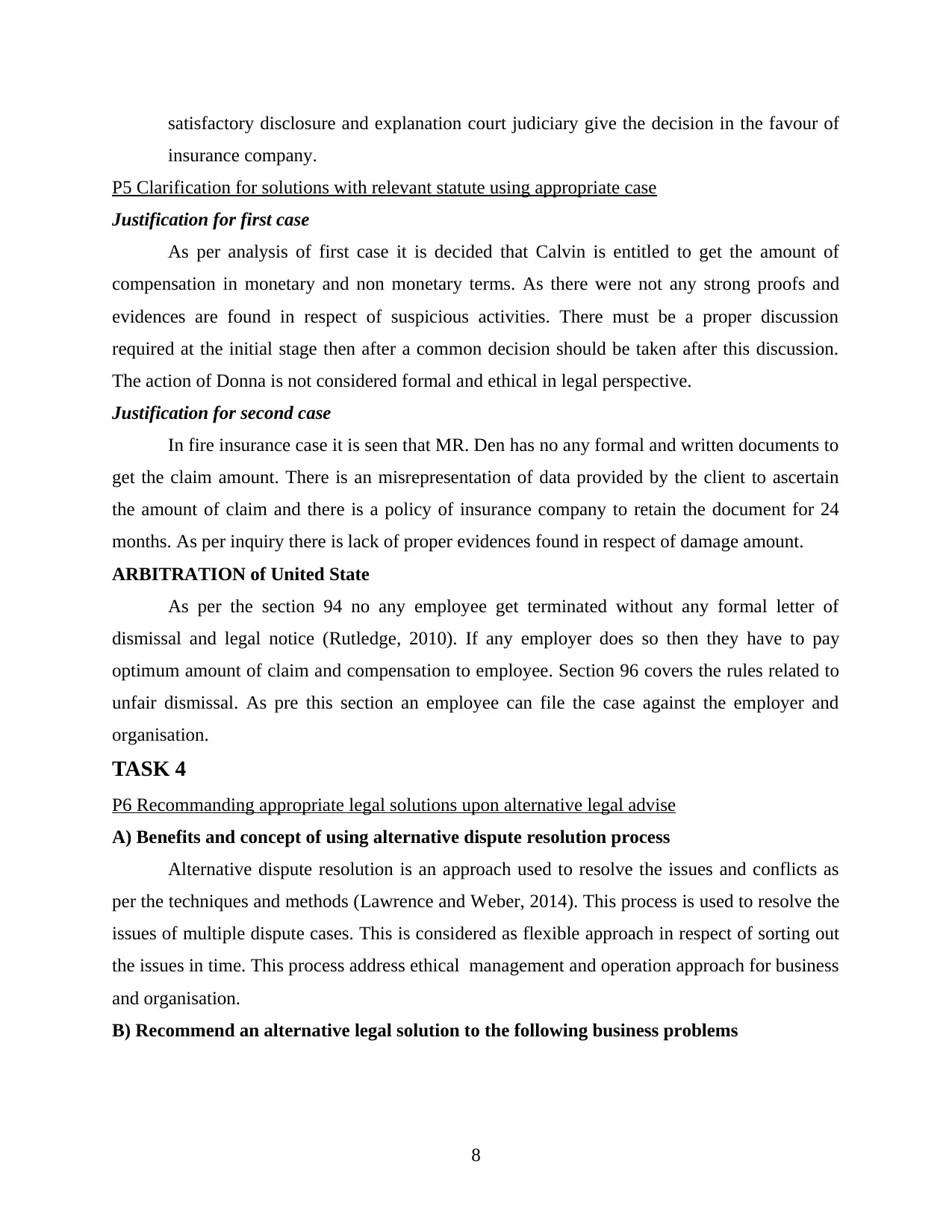
satisfactory disclosure and explanation court judiciary give the decision in the favour of
insurance company.
P5 Clarification for solutions with relevant statute using appropriate case
Justification for first case
As per analysis of first case it is decided that Calvin is entitled to get the amount of
compensation in monetary and non monetary terms. As there were not any strong proofs and
evidences are found in respect of suspicious activities. There must be a proper discussion
required at the initial stage then after a common decision should be taken after this discussion.
The action of Donna is not considered formal and ethical in legal perspective.
Justification for second case
In fire insurance case it is seen that MR. Den has no any formal and written documents to
get the claim amount. There is an misrepresentation of data provided by the client to ascertain
the amount of claim and there is a policy of insurance company to retain the document for 24
months. As per inquiry there is lack of proper evidences found in respect of damage amount.
ARBITRATION of United State
As per the section 94 no any employee get terminated without any formal letter of
dismissal and legal notice (Rutledge, 2010). If any employer does so then they have to pay
optimum amount of claim and compensation to employee. Section 96 covers the rules related to
unfair dismissal. As pre this section an employee can file the case against the employer and
organisation.
TASK 4
P6 Recommanding appropriate legal solutions upon alternative legal advise
A) Benefits and concept of using alternative dispute resolution process
Alternative dispute resolution is an approach used to resolve the issues and conflicts as
per the techniques and methods (Lawrence and Weber, 2014). This process is used to resolve the
issues of multiple dispute cases. This is considered as flexible approach in respect of sorting out
the issues in time. This process address ethical management and operation approach for business
and organisation.
B) Recommend an alternative legal solution to the following business problems
8
insurance company.
P5 Clarification for solutions with relevant statute using appropriate case
Justification for first case
As per analysis of first case it is decided that Calvin is entitled to get the amount of
compensation in monetary and non monetary terms. As there were not any strong proofs and
evidences are found in respect of suspicious activities. There must be a proper discussion
required at the initial stage then after a common decision should be taken after this discussion.
The action of Donna is not considered formal and ethical in legal perspective.
Justification for second case
In fire insurance case it is seen that MR. Den has no any formal and written documents to
get the claim amount. There is an misrepresentation of data provided by the client to ascertain
the amount of claim and there is a policy of insurance company to retain the document for 24
months. As per inquiry there is lack of proper evidences found in respect of damage amount.
ARBITRATION of United State
As per the section 94 no any employee get terminated without any formal letter of
dismissal and legal notice (Rutledge, 2010). If any employer does so then they have to pay
optimum amount of claim and compensation to employee. Section 96 covers the rules related to
unfair dismissal. As pre this section an employee can file the case against the employer and
organisation.
TASK 4
P6 Recommanding appropriate legal solutions upon alternative legal advise
A) Benefits and concept of using alternative dispute resolution process
Alternative dispute resolution is an approach used to resolve the issues and conflicts as
per the techniques and methods (Lawrence and Weber, 2014). This process is used to resolve the
issues of multiple dispute cases. This is considered as flexible approach in respect of sorting out
the issues in time. This process address ethical management and operation approach for business
and organisation.
B) Recommend an alternative legal solution to the following business problems
8
Secure Best Marks with AI Grader
Need help grading? Try our AI Grader for instant feedback on your assignments.

Arbitration: this is a situation which indicates towards find out exact results and
decisions subject to dispute cases and issues (Kojima, 2010). There are two parties remain
involved in this process. It may be found in non-binding or binding form.
Mediation: this is also an another approach used to dissolve the conflicts and issues in
effective manner. There are mutual decisions are made under this process. There is a third party
remain involved in solving the issues.
Negotiation: This is the common approach used by the judiciaries (Hattam, 2014). The
affected parties are asked to sorted out the issues and conflicts by their mutual consent.
As per the guidelines and structure of resolving the issues in United States of America
disputes are critically analysed. The role of third party and authorities remain neutral. Arbitration
is considered an alternative approach of resolving the issues and conflicts with out the consent of
third party. Labour arbitration is divided in two parts as interest and grievance arbitration.
Decisions taken under this approach are considered as Arbitration award. There was the case in
which the arbitration method used to dissolve the issue. This method was used outside the court.
This process of used to sort out the issues related to business and commercial nature.
CONCLUSION
This report is prepared to explain the dimensions of law in the context of UK. English
legal structure is defined with different sources of legal solutions. How the legal terms are
implemented in organisational context. Government importance and interference in respect of
making laws and how statutory, common laws are discussed in the justice courts. Occupational
health and safety, workers compensation, harassment and equal opportunities are discussed. Case
studies are defined in respect of solving the problems and measuring the scope of legal structure.
Legal solutions are discussed subject to case scenario and alternative legal solutions are
explained in this subject. Justifications are given in respect of providing optimum decision.
Concepts and benefits are defined to solve the dispute resolution process.
9
decisions subject to dispute cases and issues (Kojima, 2010). There are two parties remain
involved in this process. It may be found in non-binding or binding form.
Mediation: this is also an another approach used to dissolve the conflicts and issues in
effective manner. There are mutual decisions are made under this process. There is a third party
remain involved in solving the issues.
Negotiation: This is the common approach used by the judiciaries (Hattam, 2014). The
affected parties are asked to sorted out the issues and conflicts by their mutual consent.
As per the guidelines and structure of resolving the issues in United States of America
disputes are critically analysed. The role of third party and authorities remain neutral. Arbitration
is considered an alternative approach of resolving the issues and conflicts with out the consent of
third party. Labour arbitration is divided in two parts as interest and grievance arbitration.
Decisions taken under this approach are considered as Arbitration award. There was the case in
which the arbitration method used to dissolve the issue. This method was used outside the court.
This process of used to sort out the issues related to business and commercial nature.
CONCLUSION
This report is prepared to explain the dimensions of law in the context of UK. English
legal structure is defined with different sources of legal solutions. How the legal terms are
implemented in organisational context. Government importance and interference in respect of
making laws and how statutory, common laws are discussed in the justice courts. Occupational
health and safety, workers compensation, harassment and equal opportunities are discussed. Case
studies are defined in respect of solving the problems and measuring the scope of legal structure.
Legal solutions are discussed subject to case scenario and alternative legal solutions are
explained in this subject. Justifications are given in respect of providing optimum decision.
Concepts and benefits are defined to solve the dispute resolution process.
9
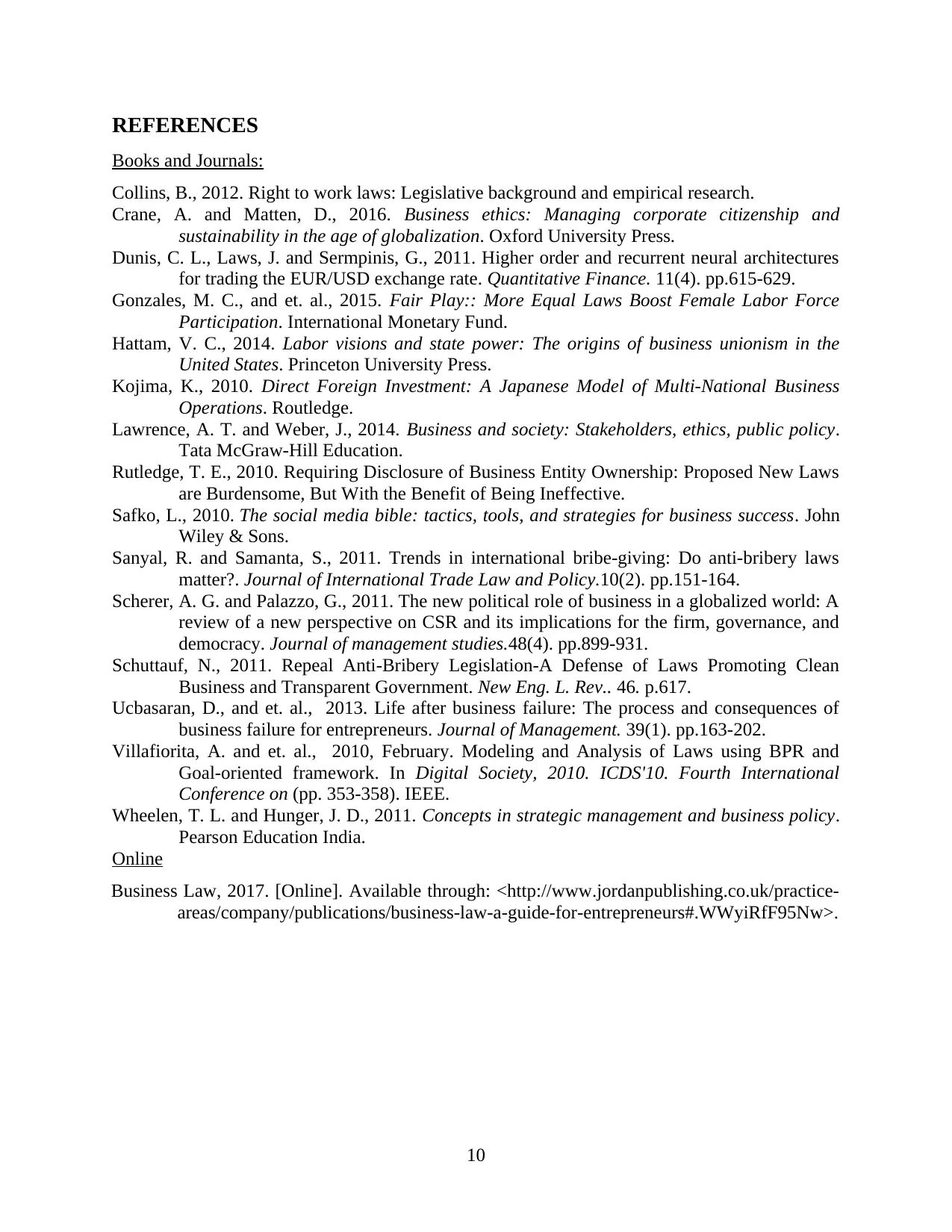
REFERENCES
Books and Journals:
Collins, B., 2012. Right to work laws: Legislative background and empirical research.
Crane, A. and Matten, D., 2016. Business ethics: Managing corporate citizenship and
sustainability in the age of globalization. Oxford University Press.
Dunis, C. L., Laws, J. and Sermpinis, G., 2011. Higher order and recurrent neural architectures
for trading the EUR/USD exchange rate. Quantitative Finance. 11(4). pp.615-629.
Gonzales, M. C., and et. al., 2015. Fair Play:: More Equal Laws Boost Female Labor Force
Participation. International Monetary Fund.
Hattam, V. C., 2014. Labor visions and state power: The origins of business unionism in the
United States. Princeton University Press.
Kojima, K., 2010. Direct Foreign Investment: A Japanese Model of Multi-National Business
Operations. Routledge.
Lawrence, A. T. and Weber, J., 2014. Business and society: Stakeholders, ethics, public policy.
Tata McGraw-Hill Education.
Rutledge, T. E., 2010. Requiring Disclosure of Business Entity Ownership: Proposed New Laws
are Burdensome, But With the Benefit of Being Ineffective.
Safko, L., 2010. The social media bible: tactics, tools, and strategies for business success. John
Wiley & Sons.
Sanyal, R. and Samanta, S., 2011. Trends in international bribe-giving: Do anti-bribery laws
matter?. Journal of International Trade Law and Policy.10(2). pp.151-164.
Scherer, A. G. and Palazzo, G., 2011. The new political role of business in a globalized world: A
review of a new perspective on CSR and its implications for the firm, governance, and
democracy. Journal of management studies.48(4). pp.899-931.
Schuttauf, N., 2011. Repeal Anti-Bribery Legislation-A Defense of Laws Promoting Clean
Business and Transparent Government. New Eng. L. Rev.. 46. p.617.
Ucbasaran, D., and et. al., 2013. Life after business failure: The process and consequences of
business failure for entrepreneurs. Journal of Management. 39(1). pp.163-202.
Villafiorita, A. and et. al., 2010, February. Modeling and Analysis of Laws using BPR and
Goal-oriented framework. In Digital Society, 2010. ICDS'10. Fourth International
Conference on (pp. 353-358). IEEE.
Wheelen, T. L. and Hunger, J. D., 2011. Concepts in strategic management and business policy.
Pearson Education India.
Online
Business Law, 2017. [Online]. Available through: <http://www.jordanpublishing.co.uk/practice-
areas/company/publications/business-law-a-guide-for-entrepreneurs#.WWyiRfF95Nw>.
10
Books and Journals:
Collins, B., 2012. Right to work laws: Legislative background and empirical research.
Crane, A. and Matten, D., 2016. Business ethics: Managing corporate citizenship and
sustainability in the age of globalization. Oxford University Press.
Dunis, C. L., Laws, J. and Sermpinis, G., 2011. Higher order and recurrent neural architectures
for trading the EUR/USD exchange rate. Quantitative Finance. 11(4). pp.615-629.
Gonzales, M. C., and et. al., 2015. Fair Play:: More Equal Laws Boost Female Labor Force
Participation. International Monetary Fund.
Hattam, V. C., 2014. Labor visions and state power: The origins of business unionism in the
United States. Princeton University Press.
Kojima, K., 2010. Direct Foreign Investment: A Japanese Model of Multi-National Business
Operations. Routledge.
Lawrence, A. T. and Weber, J., 2014. Business and society: Stakeholders, ethics, public policy.
Tata McGraw-Hill Education.
Rutledge, T. E., 2010. Requiring Disclosure of Business Entity Ownership: Proposed New Laws
are Burdensome, But With the Benefit of Being Ineffective.
Safko, L., 2010. The social media bible: tactics, tools, and strategies for business success. John
Wiley & Sons.
Sanyal, R. and Samanta, S., 2011. Trends in international bribe-giving: Do anti-bribery laws
matter?. Journal of International Trade Law and Policy.10(2). pp.151-164.
Scherer, A. G. and Palazzo, G., 2011. The new political role of business in a globalized world: A
review of a new perspective on CSR and its implications for the firm, governance, and
democracy. Journal of management studies.48(4). pp.899-931.
Schuttauf, N., 2011. Repeal Anti-Bribery Legislation-A Defense of Laws Promoting Clean
Business and Transparent Government. New Eng. L. Rev.. 46. p.617.
Ucbasaran, D., and et. al., 2013. Life after business failure: The process and consequences of
business failure for entrepreneurs. Journal of Management. 39(1). pp.163-202.
Villafiorita, A. and et. al., 2010, February. Modeling and Analysis of Laws using BPR and
Goal-oriented framework. In Digital Society, 2010. ICDS'10. Fourth International
Conference on (pp. 353-358). IEEE.
Wheelen, T. L. and Hunger, J. D., 2011. Concepts in strategic management and business policy.
Pearson Education India.
Online
Business Law, 2017. [Online]. Available through: <http://www.jordanpublishing.co.uk/practice-
areas/company/publications/business-law-a-guide-for-entrepreneurs#.WWyiRfF95Nw>.
10
1 out of 12
Related Documents
Your All-in-One AI-Powered Toolkit for Academic Success.
+13062052269
info@desklib.com
Available 24*7 on WhatsApp / Email
![[object Object]](/_next/static/media/star-bottom.7253800d.svg)
Unlock your academic potential
© 2024 | Zucol Services PVT LTD | All rights reserved.





